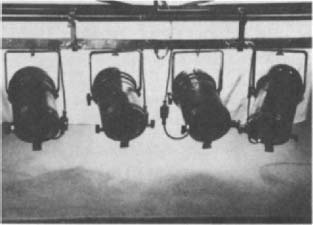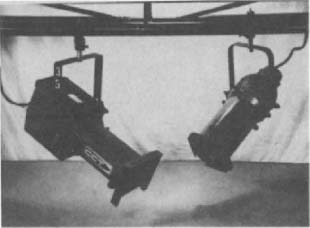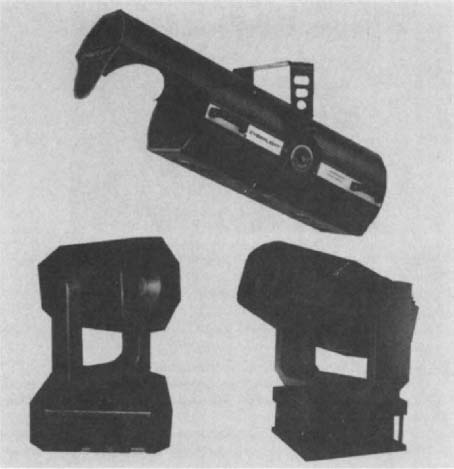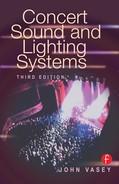CHAPTER 15
LAMPS
Lamp is the general term for an incandescent light source. A number of lamps are available to provide a wide range of wattage at different voltages (Figure 15–1).
The intensity of a light is determined by the throw, the distance from the light source to the object it is lighting. The intensity is governed by the inverse square law. Once a beam leaves a light, the area illuminated by the beam increases the farther it throws, and the same quantity of light must illuminate a larger area. If the distance between a light and the stage is doubled, the intensity is reduced to one-fourth the original.
TYPES OF INSTRUMENTS 
Par cans hold par 64 bulbs and raylight kits. The 64 refers to the diameter of the bulb in eighths of an inch. The par lamp is a tungsten-halogen (quartz) lamp with a parabolic aluminized reflector that forms part of the bulb. Par cans can be bolted onto bars, typically with six lamps, which are wired to a multiway connector. Lamp 1 on a multiway bar is the lamp closest to the connector. Par bulbs also can be used as floor lamps in short-nose cans. The only adjustment available on a par can is left-right and up-down. The bulb can be turned in the can to change the direction of the beam. When the filament is vertical, the beam is wider than when the filament is horizontal (Figure 15–2).

Figure 15–1. Lamp types. A selection of lamp types for concert lighting. (Courtesy Rank Strand.)
Profile spots can be adjusted for round size with an iris, shape with shutters, and beam edge with a lens (Figure 15–3). Adjusting the lens allows for a hard or soft edge. A smooth, even beam is the most suitable for most applications. The lenses should be mounted with the curved (convex) sides facing each other and the flat sides facing the outside and bulb. Gobos (metal stencils) can be placed in profile spots so that the image of the gobo is projected onto a screen or cyclorama.

Figure 15–2. Par cans hold par 64 bulbs and raylight kits

Figure 15–3. Profile spots. Their round size can be adjusted with an iris and shaped with shutters.
Fresnel spots let you adjust between a flood and a spot by means of moving the bulb behind the lens. Closer to the lens is a flood, and away from it is a spot.
The ground row provides four cells for four separate control channels and colors. Each cell supplies an even spread of light for lighting cycloramas or scenery.
Molefay lamps are internal reflector lamps that radiate a beam of intense light and heat. They are used in banks of eight for audience lighting and general flood.
High-intensity arc-type lights are used in follow spots and in some computerized lamps. These lamps require ballast to operate. To maintain optimum results, the quartz arc tube should not be handled. Operating the lamp for periods of less than 3 minutes seriously shortens the life of the lamp.
Most lamps work on the principle of heating a piece of wire, the filament, to the point at which it gives off light. Filaments are weakened when they are heated and are in their most delicate state while on or still warm. To avoid rough treatment of a lamp while it is on, approximate focusing of the lamps should be done at ground level so that only slight adjustment is needed in the air when the lamp is on.
With the development of microchip technology has come computerized lights (Figure 15–4). Varying degrees of technology are built around a light source. The most sophisticated models can alter pan, tilt, beam size, color, and beam shape and change with split-second timing through every degree of color in the spectrum. The most unsophisticated instruments have limited color change, movement, and beam controls. Lamps used in conjunction with a sophisticated control console give a designer an infinite number of possibilities—the only limit is the imagination.

Figure 15–4. Various types of automated instruments. VARI*LITE, Cyberlight. and Icon.
Color changers can be fitted to the front of most lamps to provide a scroll of color that is moved on rollers. The color changer is controlled by either a manual or a memory console.
HANGING LAMPS 
Lamps generally are hung on the rails of trusses with hook clamps. Bars of lamps also have hook clamps. The lamps hung on the grid must have safety wires attached, gel-frame properly seated, and have undergone testing and rough focusing before the grid is raised. Anything that falls from the truss can cause serious injury. Tape any cables running along the trusses firmly in place so they do not hinder the crew.
Lamps often are situated on the floor as well as on the grid. These lights are likely to be moved, usually because of people's ignorance of lighting and the precise nature of focusing. Any cables run out to floor lamps should cross audio cables at right angles to avoid main-induced hum in the audio cables.
